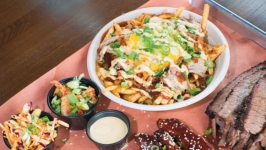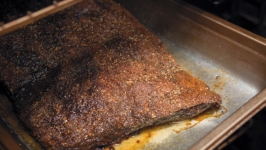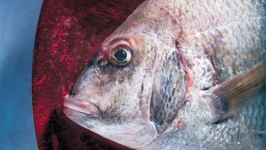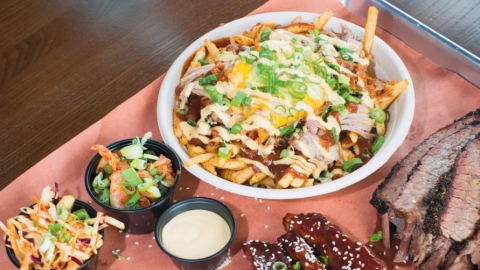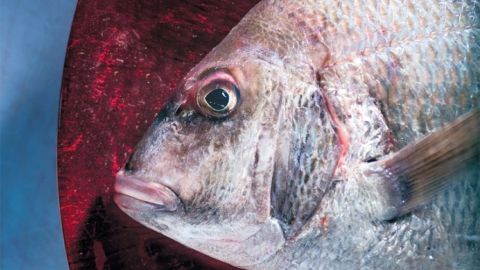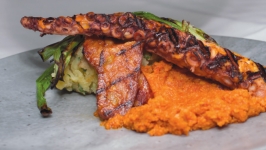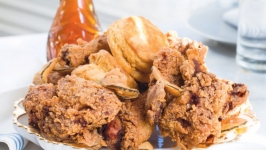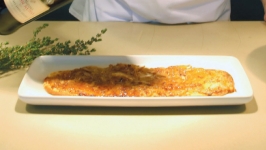Secrets of a Pitmaster
Dry rub vs. wet rub?
For smoking meats, dry rub is better because it will form a nice crust/bark. Wet rubs tend to have lots of sugar, which will burn if you smoke your meats for more than 4 hours.
Is low and slow the best approach?
Yes, low and slow is the way to go. The real question is, how low? Some people swear by 215 to 225°F, but I like it a little higher, around 250°F. For me, it’s about the bark, and to get that crusty exterior and moist interior, you must bump it up a little bit.
Is it better to marinate meat, or just barbecue it right away and let a good sauce fill in the rest of the flavor?
Marinating meats definitely has its advantages, as it can tenderize as well as add flavor. I do not marinate most of my smoked meats, but the real magic of barbecue, or roasting, for that matter, is in achieving the Maillard reaction, or the breakdown of proteins that causes the meat to brown and produces that magical flavor. Sauce has very little to do with barbecue.
Is it true that the longer you let meat marinate, the better it will be?
If you marinate it too long, the flavors can be too strong and/or too aromatic. You need to find what works for you and tweak it from there.
Barbecue tends to have a big emphasis on meat culture for main dishes. In your view, is there no such thing as good vegetarian barbecue?
The whole concept of authentic low-and-slow barbecue is about slow cooking meats over wood for a long time. I do like smoked vegetables, but I am not a believer in certain products resembling the taste of meat. If you want the taste of meat, eat meat. In a similar fashion, I don’t want my meat to taste like vegetables.
What ingredients do you think are needed to make the best barbecue flavoring?
For beef, all you need is salt and coarse pepper. For pork, paprika, garlic powder, onion powder, cumin, cayenne pepper and salt will give you the basis of a good general barbecue rub.
What wood chips are best for smoking?
You should get whatever is available. I prefer to use Post Oak, as they do in Central Texas, but in NJ we have more access to hickory and cherry. The real factor is not the wood, but the quality of the smoke. You want a nice, clean smoke, not something that is thick like a cloud. There is no need to soak wood, as the water will cause that undesired thick smoke. You don’t want smoke to be the dominant flavor profile. It should be there, but only as a component.
Are there any myths about barbecuing that you feel the need to debunk?
The myth of the smoke ring. Many people get enamored by the smoke ring (a line of pink under the crust). They think that this is the telltale sign that something has been properly smoked. It does look better, but it has no real meaning beyond that. It’s not about smoke penetration, it’s about nitrates and air. Franklin Barbecue [in Austin, Texas] is regarded as the best barbecue in the world, and their brisket doesn’t always have a smoke ring. Think about it.
Any last thoughts on what you feel makes good barbecue?
Competition barbecue vs. restaurant barbecue: These are two different animals. In competition, the ribs are not supposed to fall off the bone, but rather have a firmer texture. Generally speaking, people in restaurants want [the meat to] fall off the bone. Are they wrong? No, but if they eat competition ribs, they shouldn’t judge [them] negatively because they [don’t fall] off the bone.
Backyard barbecue vs. restaurant barbecue: People say or think that they can make better barbecue than a restaurant. I would not disagree. They should. If your guests arrive at a certain time, you know exactly what time you need [the meat] to be ready.
A restaurant has to prepare food for a much larger scale and hold that barbecue until it’s ordered. You will have different ranges of quality. Your 1pm ribs will be different than your 5pm ribs. So, before you say you can cook better than a restaurant, ask yourself if you can host a party for 100 people from 12 to 8pm and have that food [stay] consistent for the whole time.



